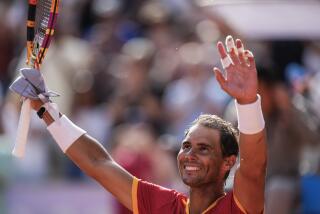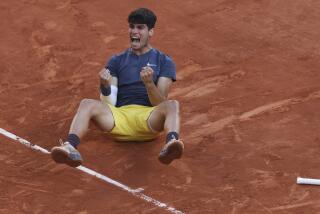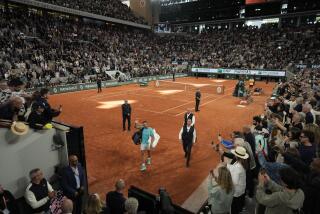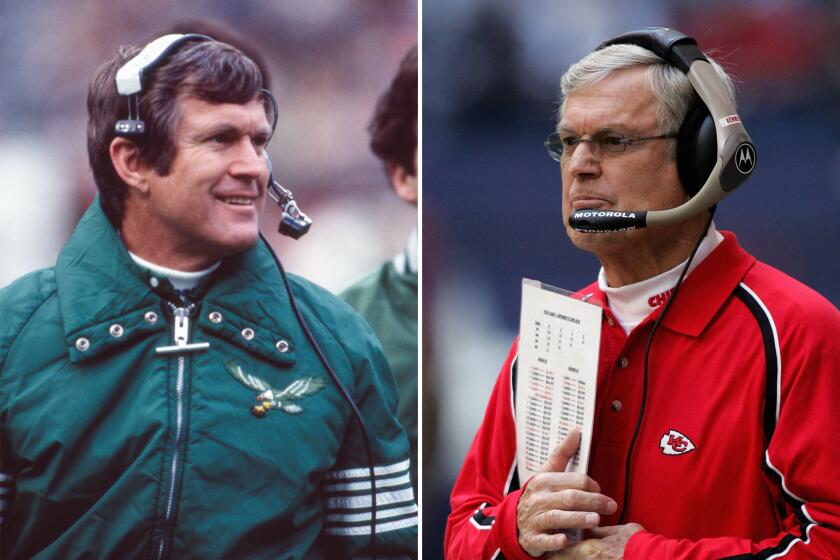At 18, Nadal Knows Lots of Dirty Tricks
- Share via
PARIS — All that’s left now is to find the right actor to play the part of rakish left-handed teenager Rafael Nadal of Spain, once he has won the French Open.
Antonio Banderas? He could easily assume Nadal’s charming manner of using “no?” at the end of almost every sentence. OK, right country, wrong age. Even in Hollywood, 44 does not easily divide into 18.
Gael Garcia Bernal? Of course his acting abilities would be tested, and then some. But he already has a head start, having played another famous lefty, a young Che Guevara, in “The Motorcycle Diaries.”
But let’s back up and explore the original premise: Nadal’s winning the French Open. Naturally, the first step is getting to the starting line, or in this case, the baseline.
Nadal, seeded fourth, has yet to play his first main-draw match on the famous red clay of Roland Garros. Injuries the last two years delayed his Paris debut.
But his five clay-court titles in 2005 and a 17-match winning streak on the surface might be the great equalizer, and some consider him one of the leading contenders, if not the favorite.
“Rafael Nadal, I see no demons in him,” three-time French champion Mats Wilander said in a recent telephone interview. “None. Unless he picks up the racket with his right hand.”
Wilander, of Sweden, would seem to know whereof he speaks. He has done the deed, albeit in quieter, simpler times, and at an even younger age than Nadal.
The 17-year-old Wilander showed up, unseeded, in Paris in 1982 and won the French Open in his first attempt, taking out a quartet of luminaries in the final rounds.
He beat Ivan Lendl in the round of 16, a net-rushing Vitas Gerulaitis in the quarterfinals, Jose Luis Clerc in the semifinals and Guillermo Vilas in the final.
Wilander joked about his lack of expectations when he arrived in Paris, saying he felt he should still have been playing in juniors, since he had won the junior title the year before. He said he changed his plane reservation three times during the fortnight on clay.
“I did not expect to win,” he said. “I expected to play at a certain level. I had no clue if it was going to carry me anywhere. That’s the main difference from Nadal. He knows if he plays at a certain level -- in a way I would say it’s easier for him because he knows this is enough.”
Beyond the lefty creativity, the guile and the spin, it’s all about the heart, el corazon, as far as Wilander is concerned.
Nadal has hardly been overwhelmed during the biggest tests in his short tennis life. He reveled in the pressure of the Davis Cup final, for instance, beating Andy Roddick on the first day in Seville, in front of a record 27,000 fans.
His heart seems to be about as big as the one that three-time champion Gustavo Kuerten of Brazil used to draw in the clay at the French Open.
“He impresses you because he brings heart and a strong mind-set to the court,” Wilander said. “We’ve been thinking that’s not enough anymore, but if you have a big heart as he does and that kind of game to back it up. ... It’s all about heart. He’s not thinking about his shots, he’s thinking about what the other guy is doing.”
Former French Open champion Andre Agassi spoke of how Roger Federer has transformed the sport, and the increasing influence of Nadal and 18-year-old Richard Gasquet of France.
“It’s almost in hindsight you can look back at five-year marks and see that there’s been a transition in not just who the players are, but also the way the game’s being played,” Agassi said Saturday at a pre-tournament news conference.
“There are a few guys out there that play the game in a way that pushes the game forward. Obviously, Roger has been one of those guys for a while. I think Nadal has also shown that there’s a way of playing this game that people haven’t done yet, especially on the clay. It’s time. It happens sooner or later when the real special ones start coming around. I think over the next five years, there’s going to be a lot of titles decided by these guys.”
Then there’s the body that has been described more in soccer terms than tennis ones. Nadal’s uncle is former Spanish international Miguel Angel Nadal, a rugged defender who was given the nickname “the Beast of Barcelona,” supposedly by a British newspaper, during the European championships in 1996.
Not surprisingly, the 6-foot-1, 188-pound nephew is starting to hear similar things after winning three consecutive clay-court tournaments -- Barcelona, Monte Carlo and Rome -- and going 31-2 on the surface this year.
“Nadal is such a physical animal. He’s 18 now, and he’s built like a Mack truck,” U.S. Davis Cup captain Patrick McEnroe said on an ESPN conference call last week. “He’s got so much intensity, so much energy.”
McEnroe was asked if Nadal reminded him of anyone.
“No, he doesn’t,” McEnroe said. “He’s sort of got the physical intensity, and arrogance of [Thomas] Muster in his prime, but it took Muster a while to get there.”
Commentator Mary Carillo chimed in, citing another difference: “Muster was utterly artless.”
So Nadal has art, grace, style -- if you like his calf-length pedal pusher pants -- and power going for him. And modesty in his public comments. He protested vehemently at being called the French Open favorite after winning at Monte Carlo, using his word of choice with reporters, saying, “No, no, no. I am not favorite, no. Is my first Roland Garros.”
With all this, and his 19th birthday two days before the final, what could possibly go wrong? Wilander cited only one potential difficulty.
“I think Nadal’s biggest threat is the first three rounds,” he said. “He does not want to end up against a type like Albert Costa. He’s the most vulnerable in the first three rounds.”
Score one for prescience. Wilander made that comment well before Friday’s draw. If anything, what happened was potentially worse for Nadal than drawing former champion Costa. Nadal could face a budding French hero, fellow teenager Gasquet, in the third round. He beat Gasquet in Monte Carlo but needed three sets.
Roland Garros will be a different proposition -- playing a Frenchman in the French Open. Just ask Wilander about when he came back to defend his French title in 1983 and reached the final.
“In ‘83, I had a very similar season to what Nadal is having now,” Wilander said. “I won three clay-court tournaments. I would have won the French Open if Yannick Noah wasn’t on the other side.
“It’s just too many French people in one day.”
*
(BEGIN TEXT OF INFOBOX)
First time around
How some French Open champions fared in their first trips to Roland Garros:
* Bjorn Borg: Debut at French Open: 1973, fourth round. First title: 1974.
* Michael Chang: Debut: 1988, third round. Won in 1989.
* Jim Courier: Debut: 1989, fourth round. First title: 1991.
* Thomas Muster: Debut: 1985, first round. Won in 1995.
* Guillermo Vilas: Debut: 1975, runner-up. Won in 1977.
* Mats Wilander: Debut: 1982, champion.
* Andre Agassi: Debut: 1987, second round. Won in 1999.
* Gustavo Kuerten: Debut: 1996, first round. First title: 1997.
More to Read
Go beyond the scoreboard
Get the latest on L.A.'s teams in the daily Sports Report newsletter.
You may occasionally receive promotional content from the Los Angeles Times.











